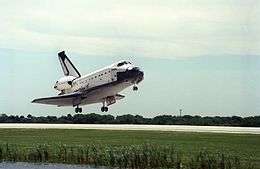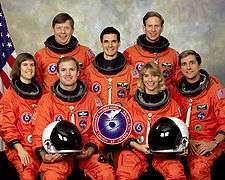STS-83
 Columbia returns to the Kennedy Space Center following a fuel cell problem which caused its mission to be aborted after four days | |
| Mission type | Microgravity research |
|---|---|
| Operator | NASA |
| COSPAR ID | 1997-013A |
| SATCAT no. | 24755 |
| Mission duration |
3 days, 23 hours, 13 minutes, 38 seconds (Planned for 15 days and 16 hours) |
| Distance travelled | 2,400,000 kilometres (1,500,000 mi) |
| Spacecraft properties | |
| Spacecraft | Space Shuttle Columbia |
| Launch mass | 117,546 kilograms (259,144 lb)[1] |
| Landing mass | 106,724 kilograms (235,286 lb)[2] |
| Payload mass | 11,377 kilograms (25,082 lb)[3] |
| Crew | |
| Crew size | 7 |
| Members |
James D. Halsell Susan L. Still Janice E. Voss Michael L. Gernhardt Donald A. Thomas Roger Crouch Greg Linteris |
| Start of mission | |
| Launch date | 4 April 1997, 19:20:32.074 UTC |
| Launch site | Kennedy LC-39A |
| End of mission | |
| Landing date | 8 April 1997, 18:33 UTC |
| Landing site | Kennedy SLF Runway 33 |
| Orbital parameters | |
| Reference system | Geocentric |
| Regime | Low Earth |
| Perigee | 298 kilometres (185 mi) |
| Apogee | 302 kilometres (188 mi) |
| Inclination | 28.45 degrees |
| Period | 90.5 min |
|
 Left to right - Front row: Voss, Halsell, Still, Thomas; Back row: Crouch, Linteris, Gernhardt | |
STS-83 was a mission of the United States Space Shuttle Columbia.
Crew
| Position | Astronaut | |
|---|---|---|
| Commander | James D. Halsell Third spaceflight | |
| Pilot | Susan L. Still First spaceflight | |
| Mission Specialist 1 | Janice E. Voss Third spaceflight | |
| Mission Specialist 2 | Michael L. Gernhardt Second spaceflight | |
| Mission Specialist 3 | Donald A. Thomas Third spaceflight | |
| Payload Specialist 1 | Roger Crouch First spaceflight | |
| Payload Specialist 2 | Greg Linteris First spaceflight | |
Mission highlights
This mission was originally launched on 4 April 1997, and was intended to be on orbit for 15 days, 16 hours. The mission was cut short due to a problem with Fuel Cell #2 and it landed on 8 April, after 3 days 23 hours. NASA decided to fly the mission again as STS-94, which launched 1 July 1997.
The primary payload on STS-83 was the Microgravity Science Laboratory (MSL). MSL was a collection of microgravity experiments housed inside a European Spacelab Long Module (LM). It built on the cooperative and scientific foundation of the International Microgravity Laboratory missions (IML-1 on STS-42 and IML-2 on STS-65), the United States Microgravity Laboratory missions (USML-1 on STS-50 and USML-2 on STS-73), the Japanese Spacelab mission (Spacelab-J on STS-47), the Spacelab Life and Microgravity Science Mission (LMS on STS-78) and the German Spacelab missions (D-1 on STS-61-A and D-2 on STS-55).
MSL featured 19 materials science investigations in four major facilities. These facilities were the Large Isothermal Furnace, the EXpedite the PRocessing of Experiments to the Space Station (EXPRESS) Rack, the Electromagnetic Containerless Processing Facility (TEMPUS) and the Coarsening in Solid–Liquid Mixtures (CSLM) facility, the Droplet Combustion Experiment (DCE) and the Combustion Module-1 Facility. Additional technology experiments were to be performed in the Middeck Glovebox (MGBX) developed by the Marshall Space Flight Center (MSFC) and the High-Packed Digital Television (HI-PAC DTV) system was used to provide multi-channel real-time analog science video.
The Large Isothermal Furnace was developed by the Japanese Space Agency (NASDA) for the STS-47 Spacelab-J mission and was also flown on STS-65 IML-2 mission. It housed the measurement of diffusion coefficient by shear cell method experiment, the diffusion of liquid metals and alloys experiment, the diffusion in liquid led-tin-telluride experiment, the impurity diffusion in ionic melts experiment, the liquid phase sintering II experiment (LIF), and the diffusion processes in molten semiconductors experiment (DPIMS).
The Combustion Module-1 (CM-1) facility from the NASA Lewis Research Center housed experiments on Laminar Soot Processes Experiment and the Structure of Flame Balls at Low Lewis-number Experiment (SOFBALL).
The Droplet Combustion Experiment (DCE) is designed to investigate the fundamental combustion aspects of single, isolated droplets under different pressures and ambient oxygen concentrations for a range of droplet sizes varying between 2 millimetres (0.079 in) and 5 millimetres (0.20 in). The DCE apparatus is integrated into a single width MSL Spacelab rack in the cargo bay.
The EXPRESS rack replaces a Spacelab Double rack and special hardware will provide the same structural and resource connections the rack will have on the Space Station. It will house the Physics of Hard Spheres (PHaSE) experiment and the Astro/PGBA Experiment.
The Electromagnetic Containerless Processing Facility (TEMPUS) is used for the experiments on nucleation in different flow regimes, thermophysical properties of advanced materials in the undercooled liquid state experiment, measurements of the surface tension of liquid and undercooled metallic alloys by oscillating drop technique experiment, alloy undercooling experiments, the study of the morphological stability of growing dendrites by comparative dendrite velocity measuremetns on pure ni and dilute Ni-C alloy in the Earth and space laboratory experiment, the undercooled melts of alloys with polytetrahedral short-range order experiment, the thermal expansion of glass forming metallic alloys in the undercooled state experiment, the AC calorimetry and thermophysical properties of bulk glass-forming metallic liquids experiment and the measurement of surface tension and viscosity of undercooled liquid metals experiment.
There were also experiments on measuring microgravity. They included the space acceleration measurement system (SAMS), the microgravity measurement assembly (MMA), the quasi-steady acceleration measurement system and the orbital acceleration research experiment (OARE).
The middeck glovebox (MGBX) facility supported the bubble and drop nonlinear dynamics (BDND) experiment, the study of the fundamental operation of a capillary-driven heat transfer (CHT) device in microgravity experiment, the internal flows in a free drop (IFFD) experiment and the fiber-supported droplet combustion experiment (FSDC-2).
.jpg)
Reflight
Prior to launch, and continuing through the early part of the mission, flight controllers on the ground were monitoring an anomaly within the electrical power generating Fuel Cell #2 (of three), making it appear that oxygen and hydrogen might be starting to uncontrollably mix, which could lead to detonation. Despite troubleshooting, the anomaly persisted and appeared to worsen. Mission Flight Rules required that the fuel cell be shut down once a certain voltage threshold had been crossed, and with only two of three fuel cells working, that invoked another Flight Rule which required the mission be terminated early (loss of a second fuel cell would require severe and dangerous powerdowns, though the shuttle operates normally on two). Payload Specialist Dr. Linteris described the mission as "an exercise in crisis management. The main buss alarm was going off continually."
Astronaut Chris Hadfield served as CAPCOM for STS-83. He cited NASA's decision to terminate the mission as a positive example of applying the Flight Rules body of knowledge to ensure astronaut safety: "The beauty of Flight Rules is that they create certainty when we have to make tough calls.... In real time, the temptation to take a chance is always higher. However, the flight rules were unequivocal: the Shuttle had to return to Earth."[4]
Upon landing, mission managers decided that Columbia did not need to be processed per a typical end of mission maintenance flow. Instead, they called for an unprecedented reflight of the same mission, once the normal processing could be completed (refill the propellant tanks and other consumables like oxygen, hydrogen, nitrogen, and water, change out the main engines, etc.). The same crew flew the reflight, which was designated STS-94 (the next available unused shuttle mission number at the time), three months later, in July 1997. The crew patch was updated with the reflight, changing the outer border from red to blue and changing the flight number from 83 to 94.
See also
References
- ↑ "NASA Historical Data Book, Vol. VII (Part 4)" (PDF). NASA. Retrieved 16 August 2015.
- ↑ "STS-107 MISSION MANAGEMENT TEAM (MMT) MINUTES" (PDF). NASA. Retrieved 16 August 2015.
- ↑ "NASA shuttle cargo summary" (PDF). NASA. Retrieved 15 August 2015.
- ↑ Hadfield, Chris (2013). An Astronaut's Guide to Life on Earth. Little Brown. p. 83-84. ISBN 9780316253017.
External links
- NASA mission summary
- STS-83 Video Highlights
- New Computer Operating System Rides Space Shuttle (Debian News, 1 April 1997)
![]()

